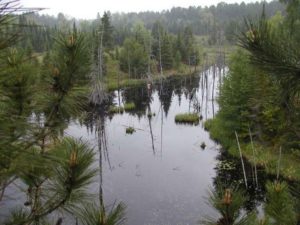The Northwoods of Wisconsin
 Teaching Drum Outdoor School is located in the Chequamegon-Nicolet National Forest of northern Wisconsin. Specifically, we are in a 40-by-60-mile area of the Forest known as the Highland Lakes Plateau, which lies on the Eastern Continental Divide. It is also called the Headwaters Wilderness because it is the fountainhead of the major rivers of northern Wisconsin and adjacent Michigan. Along with being the highest area in the upper Midwest, its beauty comes from being carpeted by dense forest and sprinkled with a profusion of glacial lakes.
Teaching Drum Outdoor School is located in the Chequamegon-Nicolet National Forest of northern Wisconsin. Specifically, we are in a 40-by-60-mile area of the Forest known as the Highland Lakes Plateau, which lies on the Eastern Continental Divide. It is also called the Headwaters Wilderness because it is the fountainhead of the major rivers of northern Wisconsin and adjacent Michigan. Along with being the highest area in the upper Midwest, its beauty comes from being carpeted by dense forest and sprinkled with a profusion of glacial lakes.
Through five thousand years of prehistory, its richness and diversity attracted more settlement than any other area of upper Wisconsin. This activity continues today because of treaty rights ensuring the Ojibwe people the right to continue using their ceded territories for subsistence, economic, cultural, spiritual, and medicinal purposes. Lying in the middle of the ceded territories, Teaching Drum is blessed by being able to witness the traditional fishing, hunting, wild ricing, and herb gathering that is near-impossible to find practiced anywhere else in this day.
The Geography
In northern Wisconsin once stood mountains taller than the Rockies, and now their eroded stubs lie buried beneath as much as 250 feet of sand and rock the continental glacier left behind when it retreated northward 10,000 years ago. Today’s lakes and hills are the pitted and wrinkled surface of that debris, which in glacialese are known as eskers (ridges), kettles (hollows), and drumlins (hills).
The Water
Since we are on the Continental Divide and the source of watersheds, we have some of the cleanest water to be found in this part of the country. The plateau’s 3,200 lakes and ponds give it what may be the greatest lake density per square mile on the planet. Forty percent of the surface area is water, which gives the climate a maritime flavor: milder weather, more fog, and fewer frosts than surrounding areas.
Forest and Wildlife
Forest County, in which Nishnajida is located, is 70 percent publicly owned and almost entirely forested. Stands of birch and maple interspersed with groves of pine and hemlock cover the highlands. Spruce, cedar, and tamarack forests cover the lowlands and creep out onto the bogs. In season, profusions of mushrooms, berries and wildflowers dot the forest floor and clearing.
The area is home to a great variety of wildlife, ranging from abundant deer and beaver to fairly common bear and otter to rare cougar and wolf (who are just now returning). Endangered birds, such as osprey, loon, and bald eagle, are seen almost every day. Many fish species inhabit the waters.
Visit our Northwoods photo gallery to see some amazing pictures of the natural habitat of Northern Wisconsin.
